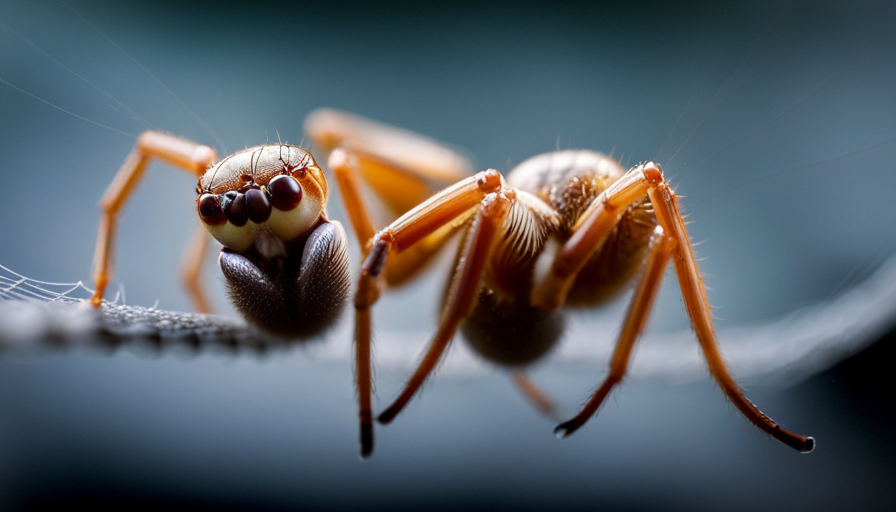Imagine yourself as a small domestic spider, creating delicate silk webs in the nooks and crannies of a house, patiently waiting for your next meal to arrive. You represent the epitome of a clever hunter, quietly trapping unsuspecting prey in your intricate traps. But have you ever wondered about the diet of us, the tiny household spiders?
Well, let me enlighten you. In this article, I will delve into the fascinating world of little house spider diets. As an expert arachnologist, I have spent countless hours observing and studying the feeding habits of these tiny arachnids. From their common diets to their unique hunting techniques, I will explore it all.
You will discover how little house spiders play a vital role in controlling pest populations, acting as nature’s very own exterminators. Additionally, I will shed light on the various factors that influence our dietary preferences, including the interactions we have with other house inhabitants.
So, if you’re curious about what fuels our eight-legged lives, join me on this scientific journey into the world of little house spider diets. Prepare to be amazed by the intricate web we weave in our quest for sustenance.
Key Takeaways
- Little house spiders have varied hunting strategies and prey on insects like flies, mosquitoes, beetles, and other spiders.
- They require a balanced diet rich in protein for growth and reproduction.
- Little house spiders play a vital role in controlling pest populations by preying on common household pests.
- Spiders adapt their behavior to coexist with humans in their environments.
Common House Spider Diet
So what do those little house spiders chow down on? Well, let’s take a closer look at the common house spider’s diet. These tiny arachnids are not picky eaters and have quite varied hunting strategies to catch their prey.
They mainly feed on insects such as flies, mosquitoes, and beetles. House spiders are also known to consume other spiders, including their own species. This helps control the population and reduces competition for resources.
In terms of nutritional needs, these spiders require a balanced diet rich in protein to support their growth and reproduction. They extract vital nutrients from their prey using specialized digestive enzymes. These enzymes break down the prey’s tissues, allowing the spider to absorb the nutrients.
Understanding the hunting techniques employed by house spiders provides insight into their efficient predatory behavior.
Hunting Techniques
To catch their prey, you’ll be amazed to learn that these tiny arachnids use a variety of clever hunting techniques. House spiders are skilled predators that employ different strategies to ensure successful prey capture. One common technique is web-building, where they construct intricate webs to trap unsuspecting insects. These webs are strategically placed in areas with high insect activity, maximizing their chances of catching a meal. Another hunting strategy is ambushing, where the spider patiently waits in hiding until its prey comes within striking distance. Additionally, house spiders are known to use their speed and agility to actively chase down and capture their prey. These hunting techniques allow house spiders to efficiently secure their food source. Moving on to their feeding habits and frequency, these spiders consume their prey regularly to sustain their energy levels and survival.
Feeding Habits and Frequency
In studying the feeding habits of little house spiders, I’ve observed several interesting patterns.
Firstly, these spiders exhibit regular feeding patterns, consuming prey items at consistent intervals.
Additionally, I’ve found that they aren’t limited to a single prey item, but rather have a diverse diet, consuming multiple prey items.
Lastly, I’ve noticed that little house spiders also have the ability to adapt and survive during fasting periods, indicating their remarkable survival adaptations.
Regular Feeding Patterns
Discover what little house spiders munch on regularly and satisfy your curiosity about their feeding patterns. Here are four interesting details about their hunger cues and feeding preferences:
- Hunger cues: Little house spiders rely on their senses to detect prey. They use their specialized hairs, called trichobothria, to pick up vibrations in the air and on surfaces, alerting them to the presence of potential meals.
- Feeding preferences: These spiders prefer to feast on small insects like flies, mosquitoes, and gnats. They’re especially attracted to the movement and scent of their prey, making them efficient hunters.
- Regular feeding patterns: Little house spiders typically feed once every few days. They build webs in strategic locations where they can easily capture unsuspecting insects, ensuring a steady supply of food.
- Nutritional needs: These spiders require a balanced diet to thrive. They extract nutrients from their prey, including proteins, fats, and carbohydrates, which are essential for their growth and reproduction.
Understanding these regular feeding patterns provides insights into the consumption of multiple prey items.
Consumption of Multiple Prey Items
Imagine a tiny predator, weaving its web with precision and patience, carefully selecting its next meal from a diverse buffet of unsuspecting insects. Little house spiders exhibit remarkable hunting strategies and prey preferences.
These arachnids have evolved to consume multiple prey items, allowing them to thrive in various environments. Their hunting strategies involve ambushing, stalking, or actively searching for prey. Little house spiders are opportunistic feeders, targeting a wide range of insects such as flies, mosquitoes, ants, and even smaller spiders. They are known to adjust their feeding habits based on the availability of prey in their surroundings.
By consuming multiple prey items, these spiders ensure a balanced diet and increase their chances of survival. Understanding the consumption patterns of little house spiders contributes to our knowledge of their ecological role. As we delve into fasting periods and survival adaptations, we discover just how these spiders can endure times of scarcity.
Fasting Periods and Survival Adaptations
During fasting periods, you must rely on survival adaptations to endure times of scarcity. Little house spiders have developed fasting strategies and metabolic adaptations that allow them to survive without food for extended periods of time. These adaptations include:
- Reduced metabolic rate: When food is scarce, little house spiders can lower their metabolic rate to conserve energy. This allows them to survive for longer periods without eating.
- Storage of nutrients: Little house spiders have the ability to store excess nutrients in their bodies, such as fats and proteins. These stored reserves can be used during fasting periods to sustain their energy levels.
- Web recycling: Little house spiders can recycle and reabsorb their old webs, which contain valuable nutrients. By consuming their own webs, they can extract and reuse the proteins and other nutrients present.
These fasting strategies and metabolic adaptations play a crucial role in the survival of little house spiders during times of scarcity. They enable these spiders to maintain their energy levels and survive until their next meal, which is important in controlling pest populations.
Importance in Controlling Pest Populations
You’ll be amazed at how little house spiders, like tiny pest control superheroes, can help keep your home free from unwanted insects. These arachnids play a vital role in controlling pest populations, contributing to the importance of biodiversity and maintaining ecological balance. By preying on common household pests such as flies, mosquitoes, and ants, they act as natural predators, reducing the need for chemical insecticides. Through their intricate webs and stealthy hunting techniques, little house spiders efficiently capture their prey, ensuring a pest-free environment.
To illustrate the significance of their role, consider the following table:
| Prey | Number Consumed per Week |
|---|---|
| Flies | 20 |
| Mosquitoes | 10 |
| Ants | 15 |
| Other Insects | 25 |
Their ability to control pest populations is truly remarkable. Now, let’s delve into the fascinating world of dietary variations among different spider species.
Dietary Variations among Different Spider Species
Spider species exhibit diverse dietary preferences, ranging from feasting on insects to devouring larger prey like frogs and birds. These dietary variations are influenced by their hunting strategies and the availability of food sources in their habitats.
For example, some spider species are ambush predators, patiently waiting for unsuspecting insects to come within striking distance. Others are active hunters, using their speed and agility to chase down their prey. Furthermore, certain spider species have specialized feeding behaviors, such as wrapping their prey in silk before consuming it.
These dietary preferences and hunting strategies have allowed spiders to successfully adapt to different ecosystems worldwide. By controlling pest populations, spiders play a crucial role in maintaining the balance of nature.
Transitioning to the next section, it’s interesting to explore how spiders interact with human habits and environments.
Spiders and Human Habits
How do spiders adapt their behavior to coexist with humans in their environments? Spider behavior is highly adaptable, allowing them to thrive in a variety of habitats, including human dwellings.
One key aspect of spider behavior is their ability to build webs. Spiders strategically construct their webs in areas with high insect activity, such as near lights or windows. This allows them to capture prey more efficiently and minimize competition with other spiders.
Additionally, spiders often adjust their hunting patterns to coincide with human habits. For example, they may be more active at night when humans are less likely to disturb their webs.
Overall, spiders have evolved to coexist with humans by capitalizing on human-induced changes in their environment. This adaptation has enabled them to successfully establish themselves as household inhabitants alongside humans and other house inhabitants.
Interactions with Other House Inhabitants
When it comes to interactions with other house inhabitants, I’ve observed that spiders like myself have a unique coexistence with other arthropods. We share our living space, but we also engage in predation on other small insects, which helps to control their populations.
However, this also means that there’s competition for food and territory, as we all strive to survive and thrive in our shared environment.
Coexistence with Other Arthropods
While living in close proximity to other arthropods, little house spiders find plenty of food to sustain themselves. They have developed unique ways of cohabitation with other arthropods, forming symbiotic relationships with certain insects.
For example, some species of house spiders coexist with ants, benefiting from the leftover food scraps that the ants leave behind. In return, the spiders help control the ant population by preying on them.
Additionally, house spiders also form symbiotic relationships with other insects such as beetles and flies. These insects are attracted to the webs that the spiders spin, providing an additional food source for the spiders.
This coexistence with other arthropods allows little house spiders to thrive in their environment, ensuring a steady supply of food.
Moving on to their predation on other small insects…
Predation on Other Small Insects
You think those tiny insects stand a chance against the voracious appetite of these eight-legged predators? Think again! Little house spiders are skilled hunters, using a variety of hunting techniques to capture their prey.
They have regular feeding patterns, ensuring that they always have a steady supply of food.
- Ambush: These spiders patiently wait in hidden corners, ready to pounce on unsuspecting insects that come their way.
- Web-building: Some little house spiders construct intricate webs to catch their prey. Once an insect gets entangled in the web, the spider quickly immobilizes it and enjoys a hearty meal.
- Quick strikes: These agile predators can swiftly move across surfaces, chasing down their prey with lightning speed.
Their hunting techniques, combined with their regular feeding patterns, make little house spiders formidable predators in the insect world.
As they satisfy their hunger, they inadvertently create competition for food and territory with other arthropods.
Competition for Food and Territory
The voracious appetite and hunting techniques of these eight-legged predators make them formidable competitors for food and territory in the insect world. Little house spiders are not only skilled hunters, but they also exhibit a high level of aggression when it comes to securing their next meal.
Food competition among these spiders is intense, as they compete for limited resources such as small insects and other arthropods. They use their keen senses and quick reflexes to capture prey and defend their feeding grounds.
Territorial disputes are common, with spiders marking their territories with silk and engaging in aggressive behaviors to establish dominance. These competitions for food and territory are essential for the survival and reproductive success of little house spiders.
Understanding the factors influencing spider diets can provide valuable insights into their ecological roles and interactions with other organisms in their environment.
Factors Influencing Spider Diets
When it comes to the diet of house spiders, there are several factors that influence their food choices.
One important factor is the seasonal changes in prey availability. As the seasons change, different types of insects become more or less abundant, which can impact what spiders have to eat.
Additionally, environmental conditions, such as temperature and humidity, can also affect the availability of prey.
Lastly, spider size plays a role in their nutritional requirements. Larger spiders may need to consume a greater quantity or variety of prey to meet their energy needs.
Overall, these factors work together to shape the diets of house spiders.
Seasonal Changes in Prey Availability
Spider snacks shift with the seasons as prey availability fluctuates. During different times of the year, the number and types of insects that spiders can feast on change. To survive the seasonal fluctuations, little house spiders have adapted their diets accordingly.
Here are three key factors that influence their prey choices:
- In the spring, an abundance of insects such as flies and mosquitoes emerges, providing spiders with a diverse and plentiful food source.
- Summer brings a variety of flying insects like moths and beetles, giving spiders a wider range of options to choose from.
- In the fall, as temperatures drop, many insects become less active, causing spiders to rely more on stationary prey like ants and other small arthropods.
These seasonal changes in prey availability shape the spider’s diet and play a crucial role in their survival. Understanding how environmental conditions and prey abundance affect spider feeding habits can provide valuable insights into their ecology and behavior.
Environmental Conditions and Prey Abundance
Imagine how the environment around you and the abundance of prey can shape the diet of a small arachnid. Little house spiders, like many other arachnids, have specific prey selection and foraging behavior. Their diet is heavily influenced by the environmental conditions and prey abundance.
Environmental factors such as temperature, humidity, and vegetation density can affect the availability of prey species. For example, during warmer months, there may be an increase in flying insects, which becomes a primary food source for little house spiders. In contrast, during colder months, when insect activity decreases, spiders may resort to scavenging on dead insects or even cannibalism. These adaptive feeding behaviors ensure their survival and reproductive success.
As we explore further into the subtopic of spider size and nutritional requirements, we will see how these factors influence their dietary needs.
Spider Size and Nutritional Requirements
After discussing the impact of environmental conditions and prey abundance on little house spiders, it’s important to consider the role of spider size and nutritional requirements.
As spiders go through different growth stages, their nutritional needs change. Smaller spiders require smaller prey items, while larger spiders can consume larger prey. This is because the size of the prey determines the amount of nutrition the spider can obtain.
Additionally, different prey items have varying nutritional values. Some prey may provide more protein, while others may offer essential vitamins and minerals. Understanding the nutritional value of different prey is crucial for the development and survival of little house spiders.
With this understanding, we can now delve into the fascinating world of spider feeding adaptations and explore how these spiders have evolved to consume their prey.
Spider Feeding Adaptations
You’d be amazed at how cleverly little house spiders have adapted to find and devour their prey. These tiny arachnids employ various hunting strategies to ensure a successful catch.
One such adaptation is their exceptional prey recognition ability. House spiders possess specialized sensory organs that allow them to detect the vibrations and movements of potential prey, enabling them to locate their next meal with remarkable accuracy.
Once a suitable target is identified, these spiders utilize their agility and speed to capture their prey. They may employ stealthy stalking techniques or quickly pounce on unsuspecting insects. With their sharp fangs and venomous bites, house spiders efficiently immobilize their victims before consuming them.
These feeding adaptations have enabled house spiders to thrive in a variety of environments, ensuring a steady supply of food. However, despite their impressive hunting skills, there are often misconceptions about house spiders’ diets.
Misconceptions about House Spiders’ Diets
When it comes to the diets of house spiders, there are several misconceptions that need to be addressed. Contrary to popular belief, house spiders do not solely survive on flies and other insects that accidentally stumble into their webs. In fact, these arachnids have a variety of hunting techniques to secure their meals.
While some house spiders do create webs to catch prey, others are active hunters, relying on their incredible speed and agility to capture their next meal. Additionally, house spiders have regular feeding patterns, typically consuming small insects like mosquitoes, gnats, and ants. They’re opportunistic feeders and will take advantage of any available food source.
Understanding the true nature of a house spider’s diet helps us appreciate their role in maintaining a balanced ecosystem within our homes.
Frequently Asked Questions
Can house spiders survive without food for long periods of time?
Yes, house spiders can survive without eating for long periods of time. When deprived of food, their metabolism slows down, allowing them to conserve energy. They can survive for weeks or even months without feeding. However, prolonged starvation can weaken them and affect their ability to reproduce. Without food, their bodies will begin to break down their own tissues for energy. Ultimately, if house spiders don’t eat, they may die from starvation.
Do house spiders only eat insects or can they eat other types of food?
House spiders have a varied diet, which includes not only insects but also other types of food. While insects are their primary source of nutrition, house spiders can also consume other small creatures such as ants, beetles, and even other spiders.
Moreover, they can survive on alternative food sources like pollen, nectar, and plant matter. This adaptability in their diet allows house spiders to thrive in various environments and ensures their survival even when insects are scarce.
How often do house spiders need to eat in order to survive?
House spiders, like me, have a voracious appetite. Our feeding habits vary depending on age. As juveniles, we need to eat more frequently to support our rapid growth and development. We require a diet rich in protein, which we obtain from insects and other small arthropods.
As we mature, our nutritional requirements decrease, and we can survive on less frequent meals. However, it’s important to note that our feeding habits can also be influenced by environmental factors such as prey availability and temperature.
Are there any specific factors that can influence a house spider’s diet?
There are several factors that can influence a house spider’s diet. One of the main factors is the availability of prey in their environment. House spiders primarily feed on insects, so if there’s a high abundance of insects in their surroundings, they’ll have a more varied diet.
Additionally, environmental conditions such as temperature and humidity can also impact spider feeding habits. These conditions can affect the activity and behavior of both spiders and their prey, ultimately influencing the spider’s diet.
What are some common misconceptions about house spiders’ diets?
Misconceptions about house spiders’ diets often arise from a lack of understanding their diverse food sources. Debunking myths is crucial for a comprehensive understanding.
Contrary to popular belief, house spiders do not solely feast on flies. Their diet expands to include a wide range of insects, such as mosquitoes, ants, and beetles. Additionally, they may occasionally consume other spiders or even small arthropods.
Appreciating the complexity of their diet is essential for appreciating their ecological role.
Conclusion
In conclusion, after delving into the intricate world of house spider diets, it becomes clear that these tiny arachnids play a vital role in our homes. Contrary to popular belief, they aren’t simply creepy crawlers, but skilled hunters that actively seek out and consume a variety of pests.
Their adaptability and specialized feeding habits allow them to thrive in different environments and contribute to the overall balance of nature. So, next time you spot a little house spider, remember, they’re nature’s secret weapon, keeping unwanted guests in check. As the saying goes, “Don’t judge a book by its cover,” and the same applies to these fascinating creatures.
I’m Theodore, and I love tiny houses. In fact, I’m the author of Tiny House 43, a book about tiny houses that are also tree houses. I think they’re magical places where imaginations can run wild and adventures are just waiting to happen.
While tree houses are often associated with childhood, they can be the perfect adult retreat. They offer a cozy space to relax and unwind, surrounded by nature. And since they’re typically built on stilts or raised platforms, they offer stunning views that traditional homes simply can’t match.
If you’re looking for a unique and romantic getaway, a tree house tiny house might just be the perfect option.










